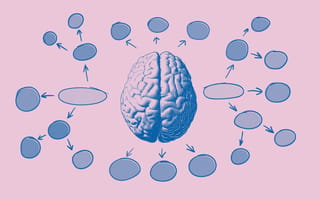If you had to identify the crux of mind mapping in a single phrase, it might be: order from chaos. The note-taking and information-diagramming technique offers a way to organize and logically link together the many various stray threads related to a given topic. It does so by visually connecting a central idea to its various subtopics and then connecting related items within those subtopics.
Mind-Mapping Tools to Know
- MindMeister
- Monday.com
- Taskade
- XMind
- Coggle
- Freeplane
- MindNode
- Whimsical
- Biggerplate
- Miro
Ironically, juggling all the considerations when choosing mind-mapping software might feel like anything but streamlined and orderly. There’s a lot to weigh. For instance: Do you need it for personal work or teamwork? Do you need to port maps into other frameworks, like Kanban? Do you need a tool that can create other diagrams beyond mind maps? And, of course, what are the pricing considerations? Below we dive into 20 noteworthy mind-mapping software options for you to try.
What Is Mind Mapping?
Mind mapping is a brainstorming technique that displays a visual representation of the mental connections you make between different ideas or topics. At the center of a mind map is a central topic, from which you draw lines or branches. Each branch contains a related topic that you associate with the main topic, summed up in one or two keywords. You can then draw lines to other subtopics, extending the tree of mental associations.
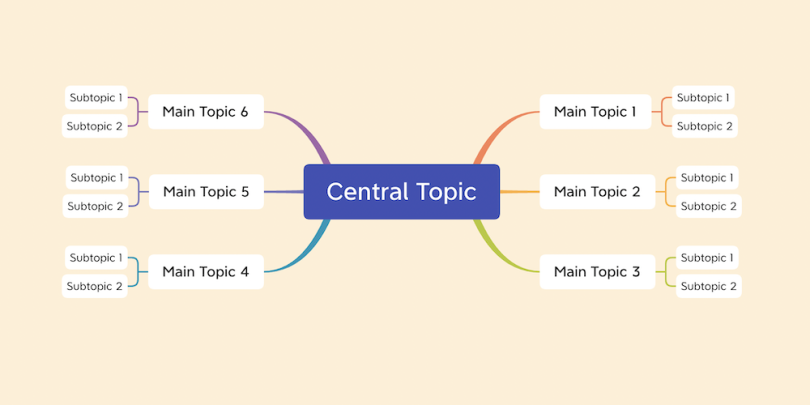
This technique emerged primarily as a way to organize notes into a more cogent structure — both hierarchical and radial — than outlines allow. But in time, that same hub-and-spoke-style layout proved useful in charting relationships for numerous business use cases. Mind mapping has borne fruit for information architecture in UX design, project management, people management, organization charting and more.
Top Mind-Mapping Software and Tools to Know
These are some of the top mind-mapping software and tools for individuals and teams looking to get the most out of their brainstorming sessions.
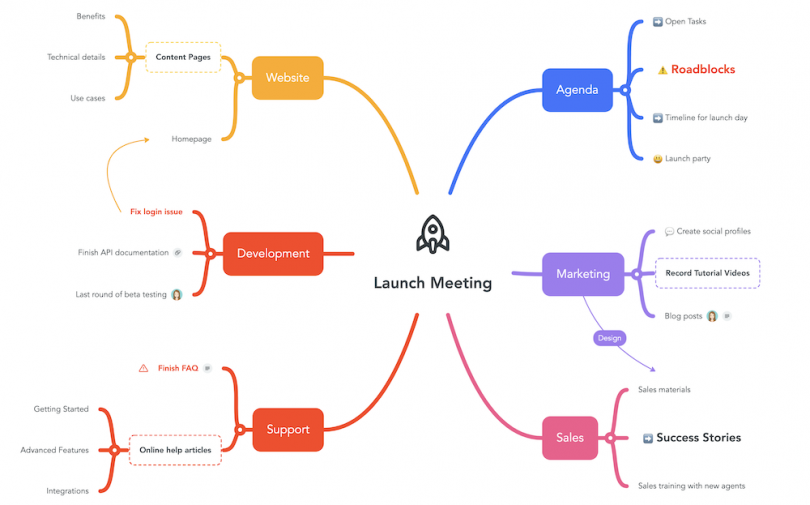
MindMeister
Who should try it? Users who need to transition from mind maps to lean development.
What it does: MindMeister has a long track record, dating back to 2007. It supports the traditional use cases associated with mind mapping, such as project management, presentation mode (users can turn branches and topics into slides) and collaborative brainstorming (multiple users can edit the same file).
Notable features: The software is maybe most noteworthy for offering a task management app, called MeisterTask. The app lets users turn subtopics and items within a mind map into tasks, then port them into a Kanban-style board, with cards positioned in columns to track states of progress. It’s a valuable feature for users who need to use mind maps as a concepting tool for a more formal product development or project management roadmap.
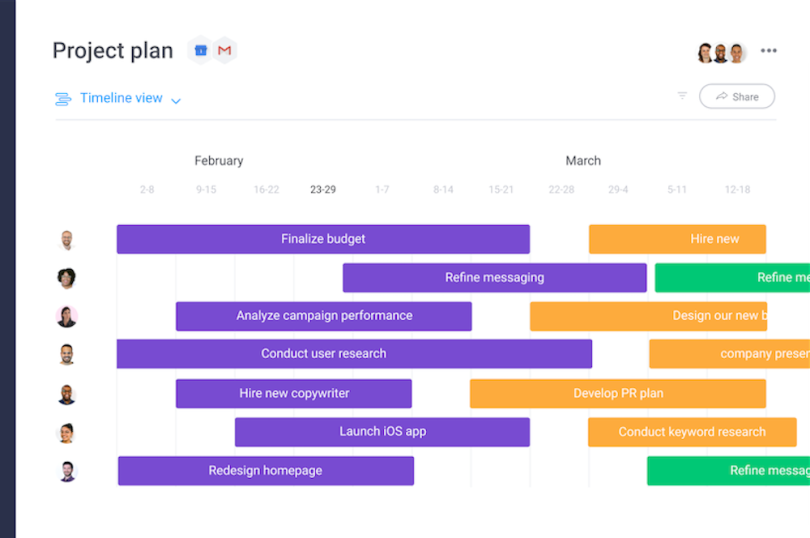
Monday.com
Who should try it? The all-in-one types.
What it does: Monday.com is among a wave of platforms that attempt to package seemingly every aspect of digital workspaces under one roof, from product timelines to calendars to meeting agendas. The wave, of course, has only intensified amid the push for remote and hybrid work.
Notable features: Monday.com has incorporated a mind-mapping visualization, built on Thoughtflow, to its selections, or views. In it, users can transform a mind-map subtopic or item into a task, which then becomes visible in the platform’s broader table view. It’s a similar concept to MindMeister’s “mind maps-meet-Kanban,” but slotted into a larger productivity suite.
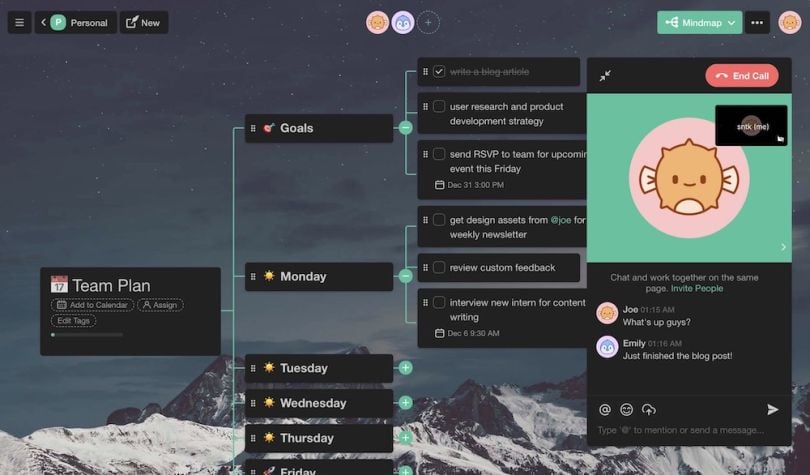
Taskade
Who should try it? Users who want to blur action and planning diagrams.
What it does: Y Combinator alum Taskade is another all-in-one-style digital workspace, with visualizations for weekly planners, meeting agendas, project boards, checklists and more. There’s also, of course, a mind map option. (Technically, it’s more of a topic map than a mind map, since it’s not radial, but users will likely find the effect the same.)
Notable features: One differentiator between Taskade and other many-view productivity workspaces is that it allows users to add assignments and due dates directly into mind map nodes — essentially blurring the line between a mind map subtopic and an action-list task. Those who appreciate that kind of intermingling, compared to a harder wall between planning diagrams and action tables, may want to give the platform a spin in the live demo window and try one of the platform’s two-dozen-plus templates to get started quickly.
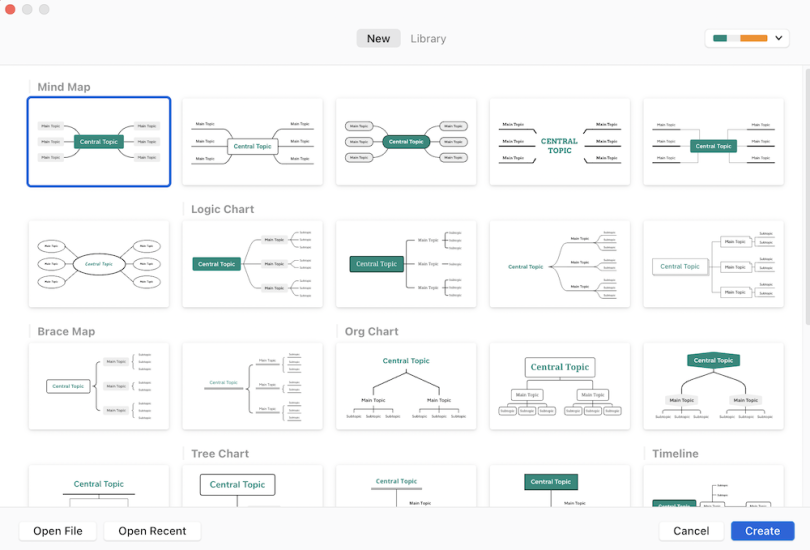
XMind
Who should try it? Users who require information diagrams beyond mind maps.
What it does: XMind covers the mind mapping basics, with several quick-reference mind map templates from which to choose, plus several options to customize from there. But what stands out most is the app’s inclusion of eight additional diagramming schemes: logic charts, brace maps, org charts, tree charts, timelines, fishbones, tree tables and matrices.
Notable features: XMind Works, which allows users to run the program on desktop or mobile without downloading the application; a toggle key that converts mind maps into outlines; and intuitive keyboard shortcuts — “enter” and “delete” adds or removes a topic, “tab” adds a new subtopic, and “space” edits branches. The software also integrates with Dropbox, Google Drive and OneDrive.
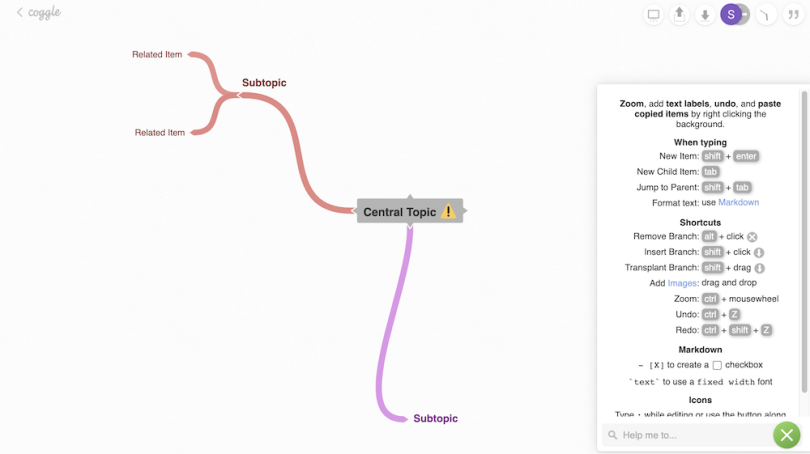
Coggle
Who should try it? Mind mappers who dabble.
What it does: Coggle is one to consider for those who mind map only on occasion. Many commercial mind-mapping software lets users create a small number of maps (three or so) before they’re asked to subscribe, but Coggle allows for unlimited free public diagrams. The hitch to note there is public. Non-private maps are included in Coggle’s available-to-all, searchable gallery, so don’t map anything you wouldn’t want the world to see. (Unlimited private maps start at $5 per month.)
Notable features: In terms of design, the web-based Coggle considers simplicity and collaboration its central features. Indeed, the no-toolbar interface remains nearly identical to when it debuted in 2013 and was described as “bare-bones” by PC World. As for collaboration, users can invite others to edit and add to a map (in real time) by clicking on the “plus” icon and dropping in an email.
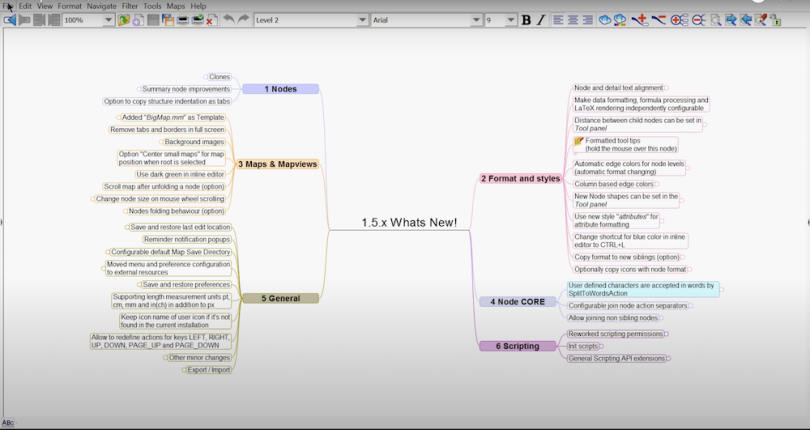
Freeplane
Who should try it? The (patient) open source devotee.
What it does: A crop of free and open source mind-mapping software emerged in the early 2000s after the technique started to gain greater popularity in the business world. One notable entry was FreeMind. A fork of that project, called Freeplane, added a slew of additional features, including formula functions (like those in spreadsheet programs) and an outline mode, plus the ability to add numerous extensions.
Notable features: Freeplane is notable among free options in that it doesn’t come with restrictions that require a subscription to bypass. At the same time, some have noted usability woes. One user described the design as clunky, “with a steep learning curve,” even while still valuing the application for being both free and flexible.
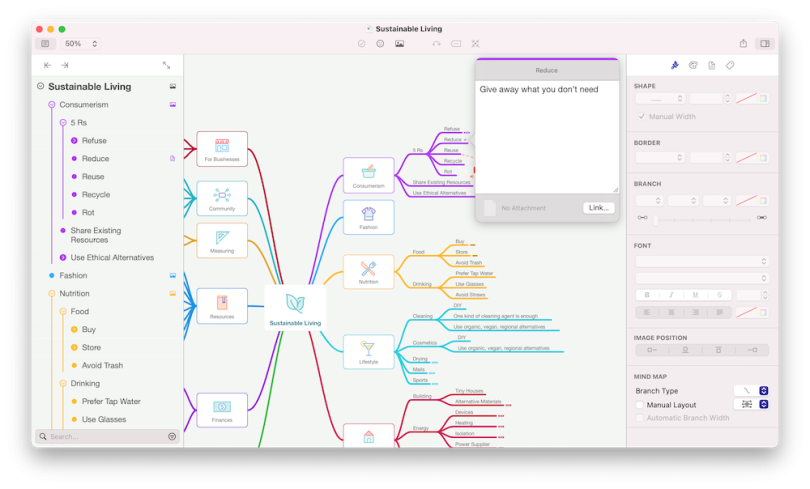
MindNode
Who should try it? Users who mind map for quick, personal brainstorming.
What it does: MindNode eschews the trends of “multiplayer” functionality and feeding into larger app ecosystems — which is what appeals to users like Kevin Trowbridge, chief technical officer of Qwoted. “I never have tried to do multi-user collaboration or had any need for it to integrate with other apps,” said Trowbridge, who considers MindNode his favorite mind-mapping app. “Basically, my mind map is highly personal and for my use only.”
Notable features: MindNode prioritizes ease of access. There’s an option to install a menu bar on desktops and app widgets on iPhones. Both allow users to quickly jot down ideas (without first opening the application), which they can later launch into a mind map. The app has also netted praise for its “level of customization and aesthetic value.”
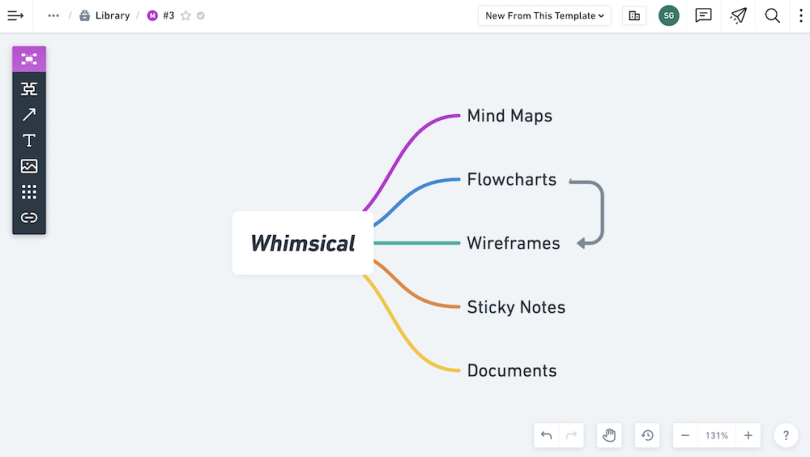
Whimsical
Who should try it? User experience and product designers.
What it does: Mind mapping is often said to be a natural fit for certain aspects of UX design, but not all such tools seem to center the needs of UX designers and product managers as digital whiteboard Whimsical does. The platform offers a range of templates for meeting notes, brainstorming sessions and other settings to facilitate idea generation.
Notable features: Whimsical allows users to build diagrams as user-journey-style flowcharts and wireframes, in addition to sticky notes, documents and mind maps. As you might expect, it also has a good reputation for ease of use and visual clarity. A notable feature: the ability to copy and paste, or drag, text from a different text application into a diagram.
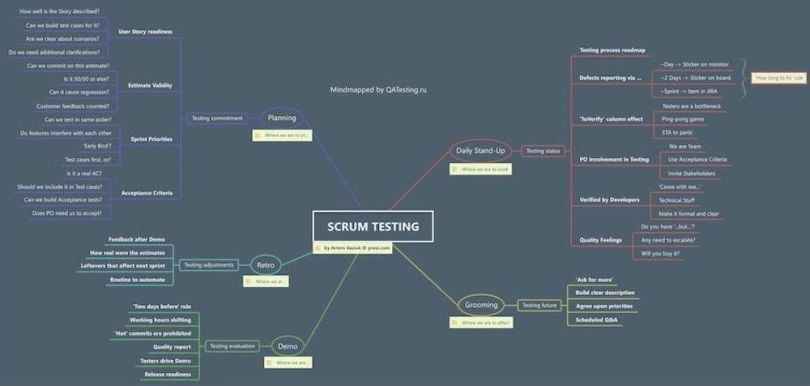
Biggerplate
Who should try it? Users looking for templates and inspiration.
What it does: Biggerplate isn’t a tool, but rather a network and library — something of a Behance or Dribbble for mind mapping. The site features a searchable database of some 17,000 downloadable templates and examples, which can be filtered by category and by software format, in order to find maps that are compatible with your preferred vendor.
Notable features: The Plus tier gets members access to e-learning courses, a library of over 250 past webinars and software discounts, among other features.
Other Mind-Mapping Tools and Software to Know
Miro: Like Whimsical, Miro is also a digital whiteboard that pairs well with UX and product design. In addition to the mind-mapping function, Miro includes tools to chart empathy maps, user personas and customer journeys. The company also announced a Zoom integration, which allows collaborative whiteboarding during video meetings.
AYOA: This whiteboard and mind-mapping application also sports Kanban, canvas, Gantt and pie-chart-style views. AYOA also promotes the app as a neuro-inclusive platform that can benefit users with dyslexia and neurodiverse needs.
Mindomo: This freemium, web-based tool supports mind mapping, plus outlining and Gantt charting. Templates are divided into education, work and personal. Mindomo also supports multi-user collaboration.
MindManager: This commercial option, launched in 1998, originated as a Windows-only product and even though a Mac version followed a few years later, MindManager is often still closely associated with Microsoft shops (it integrates with Teams) and enterprise user bases.
SimpleMind: This cross-platform tool allows users to make an unlimited number of free mind maps on an iPad, iPhone or Android. (The subscription tier supports more devices and ups the features.) It’s marketed for both personal and company use. Corporate clients include Deloitte, Cisco and Ubisoft, according to SimpleMind’s website.
Mind42: Mind42 is a free online mind mapping tool created in 2007 by IT freelancer and consultant Stefan Schuster. The software depends on ads to remain free, although users can pay for an ad-free experience. And while users can build personal mind maps for brainstorming, to-do lists and other tasks, they can also share their mind maps in the spirit of the company’s slogan “Mind FOR TWO.”
MindMup: Another free online mind mapping software, MindMup works well with HTML5 browsers since it’s written in JavaScript. Users can enjoy keyboard shortcuts, an intuitive interface and the option to convert mind maps into formats like PDFs and PowerPoints. The MindMup cloud feature also allows for simultaneous editing by multiple users.
GitMind: GitMind combines mind mapping technology with AI tools, resulting in a more efficient brainstorming process. The platform can analyze text and convert it into an organized mind map, and it also enables real-time editing and collaboration among teams. For further inspiration, users can peruse the various templates GitMind showcases.
Creately: Creately offers visualization and diagram tools for teams in marketing, HR and IT, among other departments. Users have access to more than 50 diagram standards and thousands of mind-mapping templates. After finishing a mind map in Creately, users can then export it as a JPEG file, Word doc, PDF file and other formats.
SpiderScribe: Embracing more of a free-style approach, SpiderScribe lets users add their own elements to a mind map, including files, photos and geographic locations. Users may choose to make either private or public mind maps, which they can incorporate into a website with SpiderScribe’s Embed Wizard.
MindView: MatchWare offers a mind-mapping software called MindView, which integrates with Microsoft Office products and supports real-time collaboration. Teams can also customize their visuals with other layouts besides mind maps at their disposal, including Gantt charts, diagrams and timelines. In addition, teams may switch between different layouts at any time, providing more flexibility during a project.
Frequently Asked Questions
What is mind mapping?
Mind mapping is a brainstorming technique for visualizing different concepts and ideas you associate with a main topic. A mind map starts with a central theme, from which you draw branches that connect to ideas you associate with the central theme.
Does mind mapping really work?
Mind mapping can help teams organize their thoughts and collectively brainstorm new ideas. While it’s not a replacement for other organizational methods, it can serve as a supplement that accelerates the brainstorming and idea-generation process.

